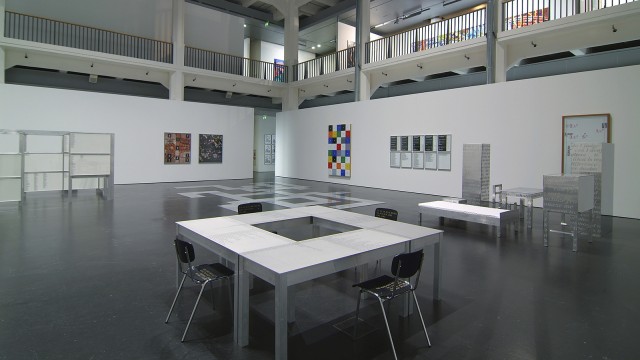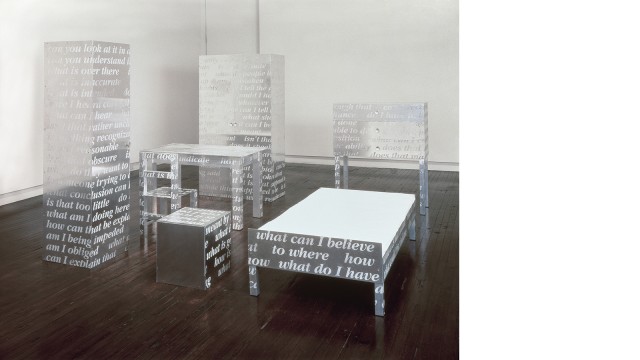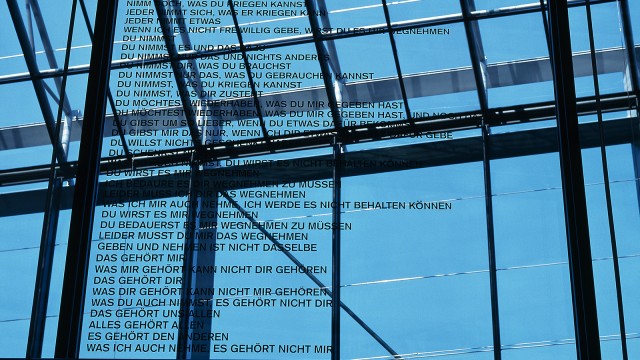
Works in the Collection
Word and image have been known as visual signifiers since ancient times. As intermedial elements on objects, in manuscripts or on panel paintings, they form a uniform semantic context that remains in use even today, for instance in the narrative form of the comic or in illustrated operating instructions for devices. Conceptual art, as seen in Tomas Locher’s work, is also based on writing and language and their interconnection with visual imagery and design. However, conceptual art draws on the insights of the linguistic turn, which started in philosophy, linguistics, and literature back in the early 20th century and began to critically question the precision and veracity of language in its capacity to communicate reality. In particular, the studies of the Austrian linguistic philosopher Ludwig Wittgenstein, specifically his theory of the “language-game”, did not conceive language as a static system. Instead, Wittgenstein saw it as constantly linked to everyday life: in doing so, he highlights the changes and limits of linguistic usage and grammar and of the language-based cognitive faculty. This then also went on to influence the fine arts from the 1960s onwards. There are numerous modalities in artistic depiction here: as a descriptive note, letter or photographic document, they are geared towards treating the abstractly devised concept underlying the physical artwork primarily in relation to its materiality. In addition, the institutional framework for viewing art (exhibition, museum, gallery, etc.), brings the context in which art is displayed into focus as a legitimizing agency of art. Consequently, normative and qualitative aspects become further factors in the issue of the artistic definition of artwork. With these premises regarding the function, form, reception, and interpretation of art, the concept of art as work undergoes a complete realignment and, for the generation of artists to which Thomas Locher belongs, constitutes a discursive framework for their own artistic work.
_1985_wrlb_1600x900_lbbw_image_w640_m.jpg)
Thomas Locher’s first group of works entitled "Lexikonarbeiten” relates to the logic of a structural order as is generally familiar from assembly-kit plans. The work "1 –32 C" (1985) is prototypical of this group of works. The metal-framed photo shows individual components, some of them grouped according to similarity of shape, with a number assigned to each part. There is no ad-hoc way of determining what machine could be built from the sum of the parts and by what method, due to the absence of an otherwise customary key. These words lack their sentence, metaphorically speaking, even though the pairings of numbers and components suggest precisely this. Therefore, the coherence of this logic known from the pattern of everyday life falls apart, and presents them as a kind of ordered nonsense within the logic of the picture. After creating these dysfunctional "Lexikonarbeiten” works, Thomas Locher intensively explored the grammar of language, the rules of its structure, its forms, and its functions in a sentence. To this end, he produced several works, some of them extensive installations, whose cubic, open, and accessible layout breaks down the one-dimensional static understanding of grammatical systems by opening up multidimensional perspectives of the linguistic order of grammar. These experiental spaces of grammar add a further dimension to making art, namely that of the public nature of language and its facilitation of social systems.
In his 1992 exhibition at the Kölnischer Kunstverein entitled "Wer sagt was und warum" (Who Says What and Why), Thomas Locher displayed a series of interiors made from inscribed metal furniture. The seven-piece ensemble “Marking and Labelling” (1991) from the LBBW Collection is a precursor to this exhibition. Its seven items of furniture are covered with italic letters and literally ask questions – the phrases include “can you understand”, “what is intended”, “what do they want”, and “what can I believe”. The high-gloss surface of the objects means that the inscriptions are partially illegible or masked. In turn, depending on where they stand, those viewing the pieces are reflected on the surfaces. In the functional interrelationship of space – object – script – question – viewer – space, the work visualizes a network of references that suggest the opportunity for a dialog, but one that cannot be conducted as such. For instance, there can be no exchange that would lead to a sequence of acts of speech. The item inscribed with questions talks, yet does not speak.

It was the French poststructuralists, predominantly Michel Foucault, and the German philosopher Jürgen Habermas who established the term “discourse” – as a conducted, debating enouncement going back and forth between participants – for their research on the dissemination of knowledge, on socially legitimized norms, and the development and assertion of the balance of power in socially institutionalized interrelationships. Consequently, the work “Marking and Labelling” must also be regarded as discursive, as it reveals an order that is constituted by representatively positioning the questions and items together, without indicating their rules for proceeding further. The problem that arises exemplarily from this is that of opacity, along with the possibility of deception, manipulation, which can lead as far as discrimination and illegality. The “discourse” concept thus introduced into Locher’s art continued in his work with the analysis of social relationships, which dealt with economic, then legislative communication and organization systems.
The work "Geben und Nehmen" (1994–1997) on the large glass facade of LBBW’s headquarters in Stuttgart consists of sentences from everyday speech that relate to “giving” and “taking” and therefore mirror exchanges via a sequence of speech acts. Along with “giving” in the sense of “sharing” (“I’ll give you something”), further statements imply motivations that are geared towards compensation (“If you give me something I’d like, I can give you what you want”), assert exclusivity (“I’ll only give it to you”) or are an appellative command (“Give it to me”). By being placed in the top half of the facade and being readable from the inside, “Geben und Nehmen” is aimed directly at the bank’s employees, who in turn look at the exterior space while relating to the work. Therefore, the facade work is conveyed as a transitional zone between work and the private sphere, the architectural internal structure of the building and urban space, and individual and systemic constitution.

Biography
Thomas Locher (*1956): Born in Munderkingen/Donau. 1977–1979 Alternative civilian service. 1979–1985 Studies art education and art history at the Staatliche Akademie der Bildenden Künste Stuttgart under Paul-Uwe Dreyer, Sotos Michou, Peter Grau, and Dr. Bernd Rau. 1985 Starts the group of works entitled "Lexikonarbeiten”, first gallery exhibitions in Germany and the UK. 1986 Moves to Cologne. 1989 Features in the exhibitions “Prospect 1989”, triennial for international art, Frankfurt, and “Art from Cologne”, Tate Gallery, Liverpool. 1990 Included in the "Aperto” section, Venice Biennale. 1992 Starts text works on the structural order of language. First institutional solo exhibitions, "Doppelzimmer" at the Kunsthalle Bielefeld, and the De Appel Foundation, Amsterdam, and "Wer sagt was wann und warum"at the Kölnischer Kunstverein. 1993 Included in the exhibition "Kontext Kunst", Steirischer Herbst ‘93, Graz. 1994 First public commissioned work for the glass facade of the new headquarters of SüdwestLB (now LBBW), entitled "Geben und Nehmen (Gläubiger und Schuldner)”. This is followed by further works for public spaces, including "Angebot und Nachfrage” for the Messe Leipzig in 1995, "Wunsch und Wille (Entweder/Oder)" for the Sophie Gips Höfe in 1996, commissioned by the Hoffmann Collection, and "Fragen" for the Landesbaudirektion Graz in 1997. 1995 First exhibition of the cycle of works on the "Grundgesetz der Bundesrepublik Deutschland” at the Kunstverein München. 1997 Exhibition "Andere Orte, Öffentliche Räume und Kunst” with Peter Zimmermann, Kartause Ittingen, Kunstmuseum Kanton Thurgau. 1999 Commissioned work for the glass facade of the ARD-Hauptstadtstudio, Berlin. 2000 Moves to Berlin. 2003 Retrospective at the Galerie der Stadt Stuttgart "Axiome der Kommunikation: Politics of Communication; Fragmente der Notstandsgesetzgebung; Knoten und Linien; Human Rights". Exhibition project "Politik der Kommunikation" with Museum in Progress and the Arbeiterkammer Wien. 2008–2016 Professor at Det Kongelige Danske Kunstakademi, Copenhagen. 2010 Features in the 6th Berlin Biennale. 2013 Solo exhibition "Homo Oeconomicus” at the Secession Wien, completion of "Nicht-Ort (Non-Site)", memorial at the former Gestapo execution site, El-De-Haus courtyard, Cologne. 2015 Solo exhibition “Doors”, KMD Kunsthalle Marcel Duchamp, The Forestay Museum of Art, Cully; included in the “5th Thessaloníki Biennale of Contemporary Art”. Since 2017 Rector of the Hochschule für Grafik und Buchkunst, Leipzig.
